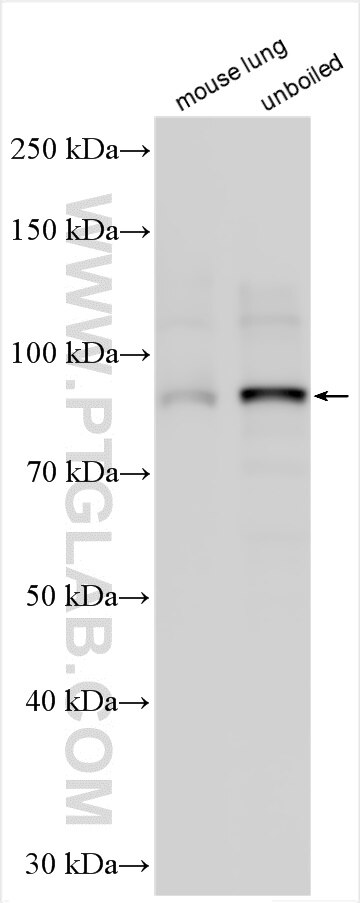- Phare
- Validé par KD/KO
Anticorps Polyclonal de lapin anti-SCARF1
SCARF1 Polyclonal Antibody for WB, ELISA
Hôte / Isotype
Lapin / IgG
Réactivité testée
Humain, souris et plus (1)
Applications
WB, IF, FC, ELISA
Conjugaison
Non conjugué
N° de cat : 13702-1-AP
Synonymes
Galerie de données de validation
Applications testées
| Résultats positifs en WB | tissu pulmonaire de souris, unboiled mouse lung tissue |
Dilution recommandée
| Application | Dilution |
|---|---|
| Western Blot (WB) | WB : 1:500-1:3000 |
| It is recommended that this reagent should be titrated in each testing system to obtain optimal results. | |
| Sample-dependent, check data in validation data gallery | |
Applications publiées
| KD/KO | See 1 publications below |
| WB | See 1 publications below |
| IF | See 1 publications below |
| FC | See 1 publications below |
Informations sur le produit
13702-1-AP cible SCARF1 dans les applications de WB, IF, FC, ELISA et montre une réactivité avec des échantillons Humain, souris
| Réactivité | Humain, souris |
| Réactivité citée | rat, Humain, souris |
| Hôte / Isotype | Lapin / IgG |
| Clonalité | Polyclonal |
| Type | Anticorps |
| Immunogène | SCARF1 Protéine recombinante Ag4621 |
| Nom complet | scavenger receptor class F, member 1 |
| Masse moléculaire calculée | 830 aa, 87 kDa |
| Poids moléculaire observé | 87 kDa |
| Numéro d’acquisition GenBank | BC039735 |
| Symbole du gène | SCARF1 |
| Identification du gène (NCBI) | 8578 |
| Conjugaison | Non conjugué |
| Forme | Liquide |
| Méthode de purification | Purification par affinité contre l'antigène |
| Tampon de stockage | PBS with 0.02% sodium azide and 50% glycerol |
| Conditions de stockage | Stocker à -20°C. Stable pendant un an après l'expédition. L'aliquotage n'est pas nécessaire pour le stockage à -20oC Les 20ul contiennent 0,1% de BSA. |
Informations générales
Scavenger receptor class F member 1 (SCARF1), also known as scavenger receptor expressed by endothelial cells (SREC)-I, belongs to the scavenger receptor (SR) superfamily. SCARF1 has been shown to bind modified low density lipoproteins (LDLs), including acetylated (Ac-) and oxidized (ox-) LDLs (PMID: 29725698; PMID: 15145948). In addition to binding and internalizing a diverse range of endogenous proteins, SCARF1 also binds a wide array of viral, fungal, and bacterial antigens (PMID: 29242513). SCARF1 has a calculated molecular weight of 87 kDa, with a molecular weight of 140-160 kDa due to N-glycosylation (PMID: 22279061; PMID: 15145948). SCARF1 can also exist as a dimer (~ 180 kDa) and a truncated soluble form (~ 60 kDa) (PMID: 29242513; PMID: 29725698).
Protocole
| Product Specific Protocols | |
|---|---|
| WB protocol for SCARF1 antibody 13702-1-AP | Download protocol |
| Standard Protocols | |
|---|---|
| Click here to view our Standard Protocols |
Publications
| Species | Application | Title |
|---|---|---|
Nat Immunol The scavenger receptor SCARF1 mediates the clearance of apoptotic cells and prevents autoimmunity.
| ||
Cell Prolif SCARF1 promotes M2 polarization of Kupffer cells via calcium-dependent PI3K-AKT-STAT3 signalling to improve liver transplantation. | ||
Front Immunol Neutrophil heterogeneity in complement C1q expression associated with sepsis mortality | ||
Cell Rep Fibroblast-Derived STC-1 Modulates Tumor-Associated Macrophages and Lung Adenocarcinoma Development. |


